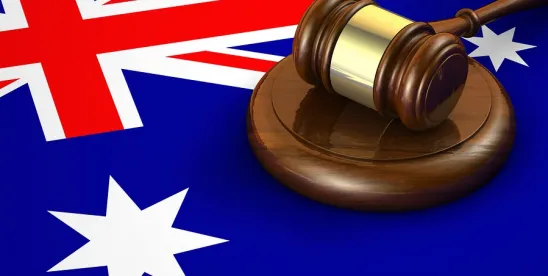On 28 March 2025, the Australian Government (the Government) published its draft Determination providing the beginnings of detail about the acquisitions that are the subject of mandatory notification, some of the exceptions to notifications, the position regarding supermarket acquisitions and the draft notification forms.
On the same day, the Australian Competition and Consumer Commission (ACCC) published its draft merger process guidelines, following on from its earlier analytical, and transition guidelines.
This Insight is part of a series of publications designed to guide clients through the upcoming Australian mandatory merger clearance regime, as the details becomes available.
In Brief
Whilst this Insight focuses on the key definitions in the Government's draft Determination, We will shortly publish additional articles focusing on the ACCC's draft guidelines. The determination:
- Confirms or defines the types of acquisitions that are the subject of the regime.
- Clarifies that the test for whether an acquisition is to be notified is based on the turnover of the acquirer and the target – and no other measure.
- It then clarifies that the relevant measure of turnover of each of the acquirer and the target is the current Goods and Services Tax (GST) Turnover of the relevant entity and connected entities (being associated entities and controlled entities).
As a practical matter, this means the following for parties seeking to enter into negotiations for mergers and acquisitions (M&A), including considering the broader meaning of "acquisition", at an early stage of the proposed acquisition or deal:
- The acquirer needs to, for the purposes of ACCC Notification, consider the turnover of itself and the target;
- The acquirer needs to calculate the GST turnover for the 12 months up to the date of the signing (and notionally at the commencement of negotiations) of both itself, including connected companies, plus, the GST turnover of the target (and its connected entities in the case of acquisitions of shares), to seek to calculate the AU$200 million or the AU$500 million threshold;
- The above calculation will also be relevant to the calculation of the AU$50 million or AU$10 million threshold; and
- The acquirer needs to consider the market value of, or consideration for, all the shares or assets the subject of the transaction for assessment of the AU$250 million transaction value threshold.
The same assessment in respect of serial or creeping acquisitions is set out below.
- It provides detail about exceptions from notification under the regime, namely acquisitions:
- Of land in certain circumstances;
- By liquidators/administrators etc;
- In the context of succession; and
- Of financial securities, exchange traded derivatives, in money lending situations and in trust circumstances.
- Mandatory notifications in the case of acquisitions by Coles or Woolworths.
- The information requirements in Notification Forms – short and long-form.
In More Detail
As previously mentioned, the Government recently released the exposure draft of the Competition and Consumer (Notification of Acquisitions) Determination 2025 (Determination) and related draft explanatory memorandum.
Additionally, on 28 March 2025, the ACCC published its draft merger process guidelines, building on its earlier draft analytic guidelines and transition guidelines.
As clients are focused on what amounts to a notifiable acquisition and if a transaction is notifiable, and what information is required to be provided to the ACCC, this insight focuses on the Determination. We will shortly publish a follow-up insight focusing on the process of interaction with the ACCC both informally and once a formal application is made.
What is an Acquisition
The Determination confirms that acquisitions are mandatorily notifiable in the following circumstances:
- The acquisition is of shares in the capital of a body corporate or assets;
- The shares or assets are "connected with Australia";
- The acquisition satisfies the combined acquirer/target turnover test on the contract date or the accumulated acquired shares or assets turnover tests (set out in more detail below); and
- The acquisition is not covered by the exceptions.
We elaborate on these issues below, apart from confirming that the term "assets" is very broad, including:
- Any kind of property;
- Any legal or equitable interests in tangible assets such as options for land, leases etc;
- Any legal or equitable right that is not property or intangible assets such as intellectual property, goodwill etc;
- Any interest in an asset of a partnership, or an interest in a partnership that is not an interest in an asset of the partnership; and
- Interests in unit trusts and managed investment schemes.
What is an Acquisition That is "Connected to Australia"
An acquisition is notifiable if it meets the thresholds (below) and it is an acquisition of shares or assets connected with Australia. This means in relation to:
- A share: the share is in the capital of a body corporate that carries on business in Australia or intends to carry on business in Australia; or
- An asset that is an interest in an entity: the entity carries on business in Australia or intends to carry on business in Australia.
How the Turnover Tests are Assessed
General or Economy Wide Turnover
The general or economy wide turnover test for mandatory notification is as follows:
- The acquirer or acquirer group and target have a combined Australian turnover of at least AU$200 million; and either
- The Australian turnover of the target is at least AU$50 million (for each of at least two of the merger parties); or
- The global transaction value is at least AU$250 million.
The Determination has clarified how the turnover is to be calculated:
- In relation to the acquirer or target turnover test, if the sum of all of the following is AU$200million or more:
- The current GST turnover of each of the principal party or acquirer, together with each connected entity of the principal party;
- Where the target acquisition is in shares of a body corporate, the current GST turnover of the body corporate and each connected entity of the body corporate; and
- Where the target is an asset, the current GST turnover of the target attributable to the asset,
AND
- In relation to the target, the acquired shares or assets turnover test is the sum of all of the following is AU$50 million or more:
- Where the acquisition is in shares in a body corporate, the current GST turnover of the body corporate together with the current GST turnover of each connected of the body corporate; and
- Where the acquisition is of an asset, the current GST turnover of the target to the acquisition to the extent that is attributable to the asset.
In relation to the above:
- Connected entity meaning an associated entity as per section 50AAA of the Corporations Act, and any entity controlled by the principal party as per section 50AA of the Corporations Act; and
- Current GST turnover (which is well understood by business given it is used by business to report the value of their taxable and GST free supplies) has the same meaning as section 188-15 of A New Tax System (Goods and Services Tax) Act.
In relation to the assessment of the AU$250 million transaction value, an acquisition will meet this threshold if the greater of the following is AU$250 million or more:
- The sum of all market values of all of the shares and assets being acquired as part of the contract or arrangement; or
- The consideration received or receivable for all of the shares and assets being acquired as part of the contract or arrangement.
As a practical matter, this means the following for parties seeking to enter into negotiations for M&A, including considering the broader meaning of "acquisition", at an early stage of the proposed acquisition or deal:
- The acquirer needs to, for the purposes of ACCC Notification, consider the turnover of itself and the target;
- The acquirer needs to calculate the GST turnover for the 12 months up to the date of the signing (and notionally at the commencement of negotiations) of both itself, including connected companies, plus, the GST turnover of the target (and its connected entities in the case of acquisitions of shares), to seek to calculate the AU$200 million threshold;
- The above calculation will also be relevant to the calculation of the AU$50 million threshold; and
- The acquirer needs to consider the market value of, or consideration for, all the shares or assets the subject of the transaction.
Very Large Corporate Group Turnover
The very large corporate group turnover test for mandatory notification is as follows:
- The acquirer or acquirer group (i.e. the principal acquirer party and each connected entity) have a combined Australian current GST turnover of at least AU$500 million; and
- The Australian current GST turnover of the target (the same approach to the assessment being the same as above) is at least AU$10 million (for each of at least two of the merger parties).
The Assessment of Serial or Creeping Acquisition
An acquisition satisfies the AU$50 million or AU$10 million threshold for accumulated acquired shares or assets turnover test for notification if:
- The acquisition is of shares or assets; and
- The principal acquirer or each connected entity have acquired other shares or assets in the three years ending the date of entering into the agreement or arrangement; and
- Both the current acquisition (of shares or assets) and the previous acquisition, related directly or indirectly to the carrying on of a business involving the supply or acquisition of the same or substitutable or otherwise competitive with each other (disregarding geographic factors or limitations); and
- The acquisition of the previous shares or assets and the current shares or assets, if treated as a single acquisition would satisfy the AU$50 million or AU$10 million acquired shares or assets turnover test; unless
- The current GST turnover of the target of the current acquisition (and as relevant connected entities) is less than AU$2 million.
Exceptions to the Requirement Make a Mandatory Notification
In addition to the exception to the requirement to notify in respect of acquisition of partial shareholdings that was included in the amending Act, the Determination sets out that acquirers are not required to notify in the following circumstances:
Certain Land Acquisitions
- Land acquisitions made for the purposes of developing residential premises; and
- Acquisitions by businesses primarily for engaging in buying, selling or leasing land, where the acquisition is for a purpose other than operating a commercial business on land (i.e. the exemption is for property development or operating a property development business rather than operating a commercial business on the premises).
Liquidation, Administration or Receivership
- An acquisition by a person in the person's capacity as an administrator, receiver, and manager, or liquidator (within the meaning of the Corporations Act).
Financial Securities
- An acquisition that results from a rights issue, a dividend reinvestment and underwriting of fundraising or buybacks, or an issue of securities (as per the Corporations Act).
Money Lending and Financial Accommodation
- An acquisition of shares or assets that is a security interest taken or acquired in the ordinary course of business of the person's business of the provision of financial accommodation (as long as the person whose property is subject to the security interest is not an associate of the acquirer).
Nominees and Other Trustees
- An acquisition of an asset, that is an interest in securities, by a person as a bare trustee, if a beneficiary under the trust has a relevant interest in the securities.
Exchange-Traded Derivatives
- An acquisition of an asset in the form of exchange-traded derivative and if at the time, the derivative confers an equitable interest in a share or assets, the acquisition of that equitable interest.
Notification Requirements for Coles and Woolworths
The Determination requires Coles and Woolworths (major supermarkets) and connected entities to make a notification for any acquisition of shares or assets that results in:
- Coles or Woolworths acquiring in whole or in part, a supermarket business (a supermarket business as defined in section 5 of the Competition and Consumer (Industry Codes – Food and Grocery) Regulation 2024; or
- Coles or Woolworths acquiring a legal or equitable interest in land (in whole or in part), either existing land that has a building with a gross lettable area of 700sqm or if it does not have an existing building, the land is 1,400sqm,
UNLESS
- The acquisition is not the extension or renewal of a lease for land upon which Coles or Woolworths was already operating a supermarket on the land.
Notification Forms – Information and Documentary Requirements
The Determination sets out the requirements for each of Short-Form Notifications (for acquisitions that were unlikely to raise competition concerns) and Long-Form Notifications (for acquisitions that required greater consideration of their effect on competition).
The Determination sets out in more detail the requirements and form of each of these notification forms, but in brief, the following are required (identifying the additional requirements for long-form application):
Documents
- The final or most recent version of the transaction documents (including sale and purchase agreements, heads of agreement, offer documents/letters of intent and any other agreements between the transaction parties related to the acquisition);
- For each party, the most recent audited financial statements and income statements that relate to the supply of goods or services most relevant to the competition analysis; and
- An organisational chart to show structure of ownerships of each party and connected entities.
In addition, for Long-Form Applications, documents from each of the parties prepared for or received by the Board, Board Committee, or equivalent (possibly Executive or senior leadership team), or the shareholders meeting within the three years prior to the date of the notification regarding:
- The rationale for the acquisition, including the business case for the acquisition or divestment;
- The assessment of acquisition including the valuation of the target; and
- Industry reports, market reports etc provided to the Board or equivalent within the previous three years describing competitive conditions, competitors, market shares and business plans (unrelated to the acquisition).
Information
- The party names, contact details and law firms representing the parties;
- An overview of:
- The goods or services supplied (or acquired) by the parties, including brands, most relevant to the acquisition;
- The transaction or transaction structure;
- The rationale for the acquisition;
- The consideration for the acquisition; and
- If relevant, any foreign filings relevant to the transaction.
- Tables for each of the parties setting out:
- Connected entities in each of the previous three years; and
- Acquisitions made by the parties (including connected entities in each of the last three years);
- Details of the competitive effects of the acquisition, including:
- The relevant goods and services and the geographic areas in which they are supplied;
- The other key suppliers of the goods/services;
- The markets that are affected and estimate of market shares (by volume, capacity or turnover in each of the previous three years); and
- The contact details of the five closest competitors, five largest customers, five customers closest to the median spend of customers.
Additional Requirements for Long-Form Applications
- Details regarding barriers to entry including:
- The costs of entry or the infrastructure required to supply the relevant goods or services and time required to put these in place, as well as the extent of these costs that are sunk or not recoverable;
- Other barriers such as access to inputs, intellectual property issues, legal and regulatory requirements, customer switching costs and time required to "win" contracts, and overall revenues to achieve minimum viable scale; and
- The entry of new competitors, as well as the exits in the previous three years.
The long-form application requires significant additional information for different types of transactions – horizontal and vertical acquisitions etc.
- Other relevant information, particularly:
- Identifying any goodwill protection provisions and the reasons that these provisions are necessary to protect the goodwill of the purchaser.
The Government has foreshadowed additional Determination, with the Determination itself having "placeholders" regarding waiver applications and the Acquisition Register – which unfortunately will now not be progressed until after the Federal election.
Tess Kane & Jenna S. Yim also contributed to this article.






 />i
/>i


